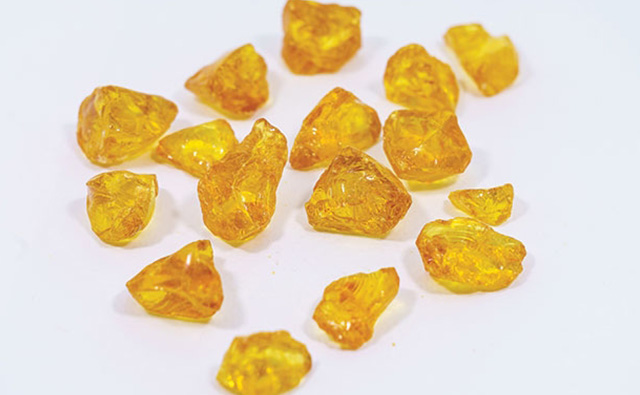Industry News, Inks
The 2018 Resin Report

Industry News, Inks

Image: ink world magazine
Resins are critical to printing inks, providing key characteristics required by brand owners, and are a sizable market.
In its report, “UV Curable Resins & Formulated Products Market by Composition (Oligomers, Monomers, Photoinitiators, Additives), Chemistry (Non-Acrylates & Oligoamines, Acrylates), Application, Technology, and Region – Global Forecast to 2023,” MarketsandMarkets estimates the global UV curable resins and formulated products market to be $4 billion in 2018. This market is projected to reach $6.31 billion by 2023, at a CAGR of 9.5% from 2018 to 2023. Epoxy acrylates and polyester acrylates are some of the most commonly used UV oligomers.
In its report, “Nitrocellulose Market Size, Share & Trends Analysis Report by Application (Printing Inks, Automotive Paints, Wood Coatings, Leather Finishes, Nail Varnishes), By Region, And Segment Forecasts, 2014 – 2024,” Grand View Research estimated the nitrocellulose market at $649.1 million in 2016, anticipating a CAGR of 6.1% over the forecast period.
“The printing ink segment is driven by technological developments and the increasing consumption of eco-friendly based inks. Usage of these products in gravure printing and flexography would give high quality and durable color paint result,” its analysts reported.
Sun Chemical CTO Russell Schwartz talked about the importance of resins to ink formulation.
“Resins bring most of the film properties needed in inks, such as gloss, adhesion and ink rheology,” Schwartz said. “The physical and chemical resistance properties of the final ink film are determined largely by the resin along with other ingredients, such as additives.”
Schwartz noted that there are different resins for each type of ink.
“There are many classes of resins used in packaging inks, including acrylic, cellulose acetate butyrate, cellulose acetate propionate, polyamide, polyurethane, vinyl and nitrocellulose,” said Schwartz.
Terry Chomniak, director of sales – process organics at Hydrite, said that business has been steady with minimal growth overall in the last year.
“Hydrite continues to see a steady growth in the ink industry, and we work with our customers focusing on addressing their needs,” added Chomniak. “Hydrite has developed a new line of products based on polyester chemistry that allow for extremely high solids for high performance ink and coating applications.”
Jeff Jacobs, North America sales manager for Indulor America, said that the overall, the resin industry fared well in 2017.
“Markets continue to grow globally,” Jacobs added. “At Indulor, graphic arts is our core business, as about 90% of our sales go into this market segment. As a result of increasing customer demand over the last few years, Indulor has undertaken major expansions in our capacity for solid resin manufacturing in Germany, and started up its new state-of-the-art polymer manufacturing facility in North Carolina in February 2017. We are therefore seeing significant growth in our graphic arts sales in North America.
“Our expectation for 2019 is to continue to grow our reputation as a reliable and technically competent supplier to the graphic arts industry beyond the European market, where we have already established ourselves as a known quantity,” Jacobs continued. “As a result of our new manufacturing operation in North Carolina, we are hoping to gain a significant market share in the North American graphic arts market.”
Resinall is focused on the litho market, and Matt Westin, director of technical services at Resinall, said that the field is still shrinking. “Our business is focused in litho, and from our vantage point the industry is still continuing to contract; 2017 again contracted by around 6%,” Weston observed. “We had hoped 2018 would level off (as we do every year) but thus far the contraction has accelerated.”
Rising resin prices are a concern for ink companies. For example, earlier this year, BASF increased prices for its Laromer UV resins in the EMEA region by 3% to 10% due to increases in raw material prices as well as REACH registration costs.
“All raw materials, including resins, are a concern for ink manufacturers,” Schwartz said.
“Methacrylates have been the main driver this past year with regards to marketplace price increases,” said Chomniak. “These increases stem from unexpected and extended plant shutdowns.”
Jacobs reported that increasing raw material costs, especially styrene and acrylates, have been a major concern this year.
“However, due to our long-term relationships with the major producers and several traders, we have been able to maintain consistent supply, even when materials were extremely short (e.g. MMA),” Jacobs added.
Weston noted that raw material prices increased last year and have continued to do so in 2018. “There is also much finished product price pressure from imported resins,” he added. “As a result we have not had success passing along any raw material price increases to customers. If this trend continues it would not be a surprise to see a domestic resin supplier exit the graphic arts industry.”
Regulations continue to expand, particularly in packaging. Low migration inks are of increasing interest in the packaging side, and Schwartz said that resin suppliers help ink companies meet the requirements of printers and brand owners.
“Due to the increasing interest of low migration inks in the packaging side of the business, one key thing that resin suppliers can do to help ink companies meet the requirements of printers and brand owners is to provide more detailed toxicity data,” Schwartz said.
Chomniak said that Hydrite is working with customers to meet their regulatory needs.
“Hydrite continues to develop polymers that require little or no low molecular weight species that might readily migrate,” Chomniak noted. “Any migratory raw materials are chosen with the appropriate FDA requirement in mind.”
“We work closely in conjunction with our customers to adjust our products to their requirements, e.g. Indulor developed special resins to help customers meet increasing regulations in Europe and worldwide,” said Jacobs. “In general, Indulor’s product portfolio has been built around glycol-ether free resin systems, so that our solutions and emulsions also contain minimal VOC levels.”